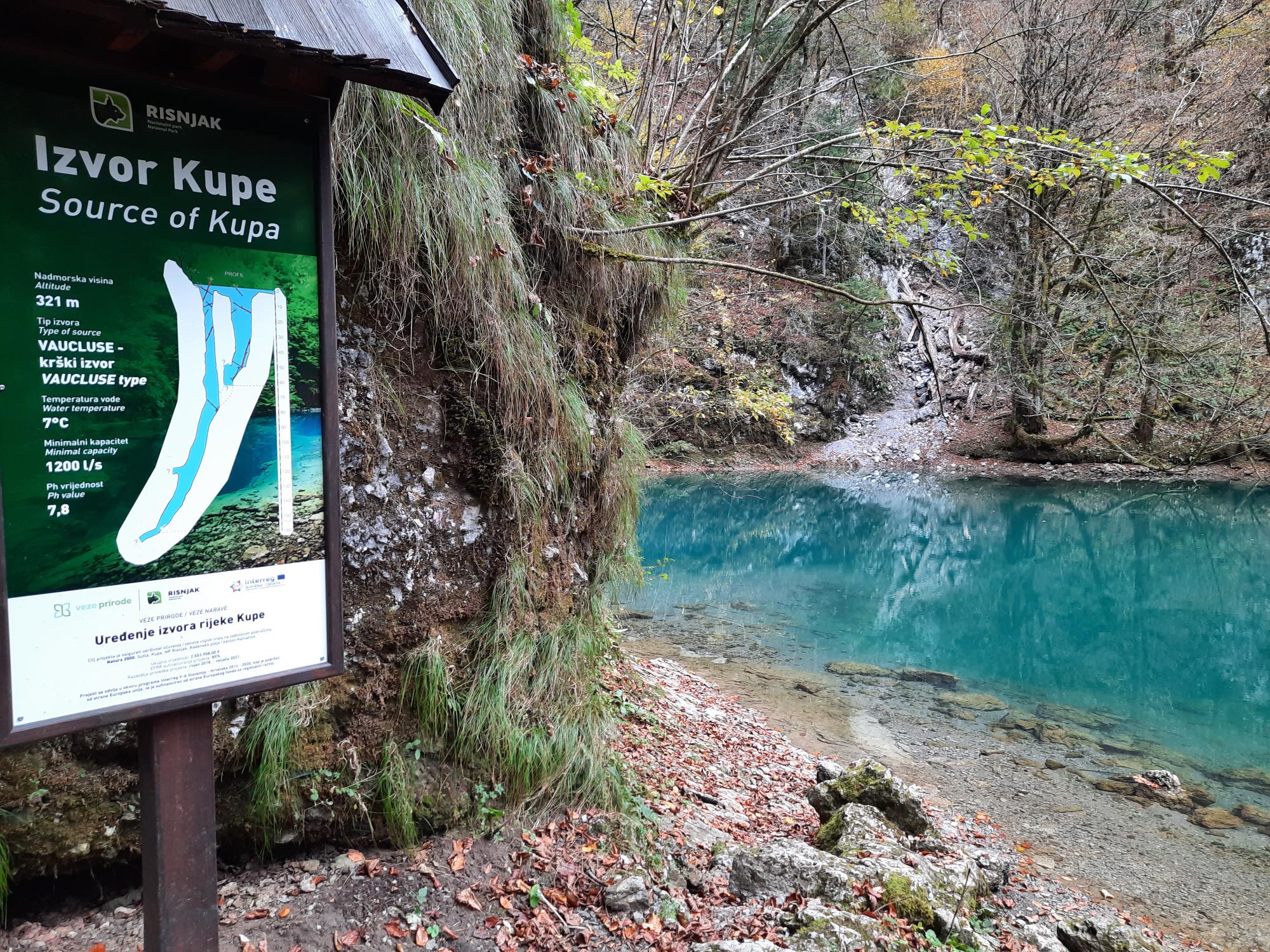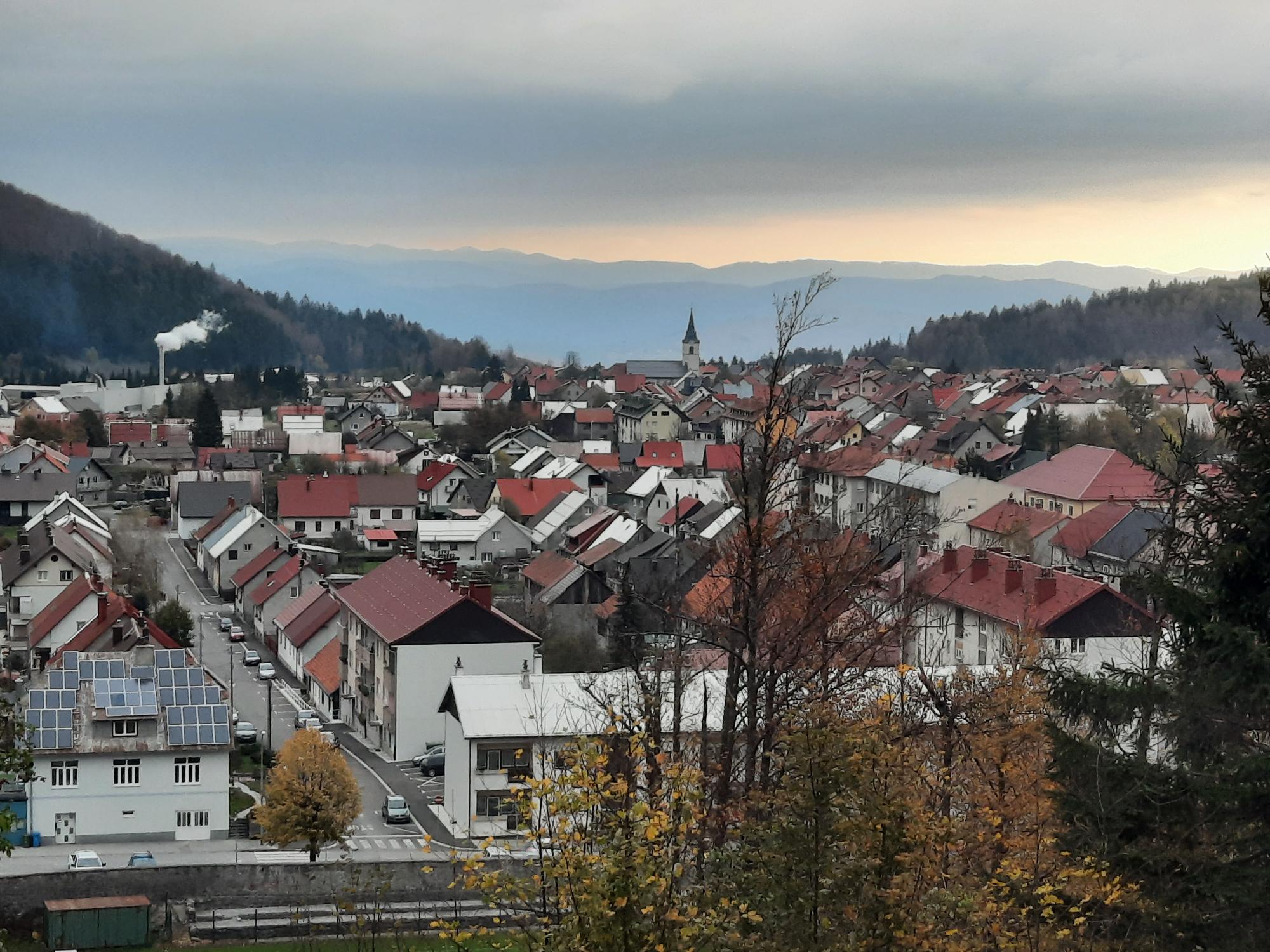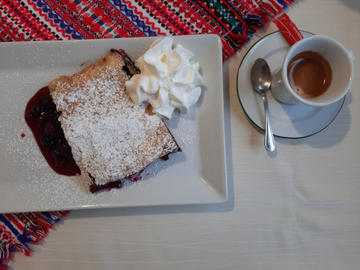Rivers of the Balkans: the Kupa
We dedicate the second chapter of our report on the rivers of the Balkans to the Kupa. The journey will lead us to talk about natural parks and migrations, borders and declining industry, barbed wire and sustainable tourism

Fiumi-dei-Balcani-la-Kupa
The source of the Kupa – photo by Giovanni Vale
"What is luxury today? Treating yourself to a smartwatch or some time for yourself? Being in the front row by the sea or in a peaceful place?". Billboards with these slogans appeared in the streets of Zagreb this summer, attracting the attention of motorists lined up along the avenue leading to the highway. The communication campaign, still ongoing, is signed by the Tourist Board of Gorski Kotar, the mountainous region halfway between the Croatian capital and Rijeka. It suggests a different approach not only to summer holidays, but also to the relationship with work and city life, at a time – the post-pandemic one – when many are rediscovering the need to be more in contact with nature.
Sparsely inhabited and covered by forests and pastures, Gorski Kotar is the region where the Kupa (or Kolpa in Slovenian), an almost 300 km long river that draws the border between Croatia and Slovenia, flows through the cities of Karlovac and Sisak, and into the Sava. We dedicate to this river the second chapter of our report on the rivers of the Balkans (the first was about the Neretva), in a journey that will lead us to talk about natural parks and migrations, borders and declining industry, barbed wire and sustainable tourism. It is a story full of facets and full of beauty. We start at the birthplace of the river, in the Risnjak National Park in Croatia, near the town of Delnice.
16 shades of forest
The main complex that marks the entrance to the Risnjak park consists of a pair of sloping-roofed buildings located on a hillock. In addition to hosting the administrative staff and offices, the structure also houses a small guesthouse with a café-restaurant. There we meet Tanja Rankovic, the head keeper leading the six rangers who patrol the park. "The park was established in 1953 and is the third oldest in Croatia. It has an area of 6,350 hectares and its main purpose is to protect the forests – explains Rankovi – there are at least 16 different types of forest in this area and a very high level of biodiversity in a relatively small space, between the continental and the Adriatic climate".
The Risnjak massif reaches a height of 1,528 metres above sea level and is home to wolves, lynxes, and brown bears. The three predators can already be observed in the atrium of the central building, on the screens that reproduce the images collected by the thermal cameras hidden in the woods. The lynx, ris in Croatian, gives its name to the park, which is one of the last areas in Croatia where this mammal, very rare even in the rest of the European continent, still survives. From the entrance to the park, various educational itineraries wind their way leading to the discovery of the bear habitat, the chamois observation points, and other destinations, but we get back in the car to reach, half an hour north, the source of the Kupa River.
A protected natural monument since 1963, the source of the Kupa officially became part of the park in 1997. To access it, you walk for about thirty minutes along a steep downhill path (the return, uphill, is quite the exercise!) until you arrive at a calm expanse of turquoise water hidden among the bare trees. We are at 321 metres above sea level – which shows the great diversity of the park with its great differences in height – and the karst river that flows before our eyes has a temperature of 7° Celsius. The depth of the source is, however, unknown. "In 2008, an expedition led by Italian speleologist Luigi Casati reached a depth of -154 metres, but it was established that it was possible to go even deeper", Rankovic says.
In this first phase of its course, the Kupa is a mountain river, narrow and capable of sudden swelling. Even near the source, where the first two tributaries (Susica and Krasicevica) join, floods periodically form (the September one took away a recently built wooden footbridge). This is, therefore, the wildest part of the waterway, where there are no campsites on the banks and not even large population centres. The first town on the river is Brod na Kupi, 26 km downstream, with under 200 inhabitants. For the rest, the Kupa passes only by groups of isolated houses and already traces the border between Croatia and Slovenia, a border which, as we will see, has only existed since 1991.
Tourism to invent
On an autumn morning, the town of Delnice appears sleepy. The capital of Gorski Kotar, where just over 5,000 people live (almost a thousand less than in 2011), no longer has that role of transit centre on the road that leads from Zagreb to Rijeka, bypassed as it is by the motorway that whizzes nearby. Almost two centuries before the motorway was inaugurated in 2008, the Lujzijana was being built in Delnice, for a long time one of the most important roads in Habsburg Croatia. Of that road, as well as of the other two built between the 18th and 19th centuries in the region (Karolina and Jozefina), many milestones and a fascinating history remain. But its role today is more touristic than strategic.
In addition to the wood industry, farming, and agriculture, the economy of Delnice and of Gorski Kotar in general is gearing towards tourism, hoping to intercept a part of the large flows that crosses Croatia every year and thus stop the depopulation of the area, which seems unstoppable. Much (if not all) of this re-conversion is related to nature, the true great potential of Gorski Kotar. Forests, rivers, lakes, ski slopes, and even some rafting on the Kupa (but not before Brod na Kupi) are what the region has to offer for travellers who want to indulge in a different kind of luxury. For the less active, there is the strudel with berries and cream, which alone is worth the trip.
Risnjak National Park is also participating in this regional transformation. As part of the Interreg cooperation programme between Croatia and Slovenia, for example, a project was financed to promote the apple varieties typical of the region (at least ten different varieties are produced) as well as the protection of local birds that frequent the orchards. Another project that saw the collaboration of Croatians and Slovenians is "Veze prirode ", the connections of nature, which obtained more than 2.5 million Euros from the Interreg programme with the aim of preserving and restoring the biodiversity of the area between the two countries, starting from the observation that "species and habitats know no boundaries".
Veze prirode made it possible to carry out research on some species, such as otters, beetles, amphibians, and about thirty different species of butterflies. The habitat of these animals has been improved with interventions along the Kupa and other rivers, where new trees have been planted, or by mowing and mulching some land, placing tree trunks (for the beetles), or even with the creation of an amphibian crossing area along the Sutla River (another tributary of the Sava which marks the border between the two states near Zagreb). Then there were mapping activities and the creation of databases that will allow a better study of the habitat of the area in the future.
Continuing the journey along the Kupa, however, we will see that if for these species the border does not actually exist, for other larger animals the border has become very real in recent years. After its most mountainous and torrential part, the Kupa slows down and widens, becoming a river that can be crossed by boat (camac is the Croatian name for the typical boat) or by swimming, while being wary of the strong current. In recent years, many refugees from the Middle East and Africa have also crossed the Kupa and, at the end of 2015, the Slovenian government set up a barbed wire fence more than 50 kilometres long to stop their passage. For the park’s mammals, who used to cross the Kupa or drink there, the new barrier is an insurmountable obstacle. And for refugees, sadly, the river has often become synonymous with death.
This content is published in the context of the “Work4Future” project co-financed by the European Union (EU). The EU is in no way responsible for the information or views expressed within the framework of the project. The responsibility for the contents lies solely with OBC Transeuropa. Go to the “Work4Future“
Tag: Work for Future
Featured articles
- Take part in the survey
Rivers of the Balkans: the Kupa
We dedicate the second chapter of our report on the rivers of the Balkans to the Kupa. The journey will lead us to talk about natural parks and migrations, borders and declining industry, barbed wire and sustainable tourism

Fiumi-dei-Balcani-la-Kupa
The source of the Kupa – photo by Giovanni Vale
"What is luxury today? Treating yourself to a smartwatch or some time for yourself? Being in the front row by the sea or in a peaceful place?". Billboards with these slogans appeared in the streets of Zagreb this summer, attracting the attention of motorists lined up along the avenue leading to the highway. The communication campaign, still ongoing, is signed by the Tourist Board of Gorski Kotar, the mountainous region halfway between the Croatian capital and Rijeka. It suggests a different approach not only to summer holidays, but also to the relationship with work and city life, at a time – the post-pandemic one – when many are rediscovering the need to be more in contact with nature.
Sparsely inhabited and covered by forests and pastures, Gorski Kotar is the region where the Kupa (or Kolpa in Slovenian), an almost 300 km long river that draws the border between Croatia and Slovenia, flows through the cities of Karlovac and Sisak, and into the Sava. We dedicate to this river the second chapter of our report on the rivers of the Balkans (the first was about the Neretva), in a journey that will lead us to talk about natural parks and migrations, borders and declining industry, barbed wire and sustainable tourism. It is a story full of facets and full of beauty. We start at the birthplace of the river, in the Risnjak National Park in Croatia, near the town of Delnice.
16 shades of forest
The main complex that marks the entrance to the Risnjak park consists of a pair of sloping-roofed buildings located on a hillock. In addition to hosting the administrative staff and offices, the structure also houses a small guesthouse with a café-restaurant. There we meet Tanja Rankovic, the head keeper leading the six rangers who patrol the park. "The park was established in 1953 and is the third oldest in Croatia. It has an area of 6,350 hectares and its main purpose is to protect the forests – explains Rankovi – there are at least 16 different types of forest in this area and a very high level of biodiversity in a relatively small space, between the continental and the Adriatic climate".
The Risnjak massif reaches a height of 1,528 metres above sea level and is home to wolves, lynxes, and brown bears. The three predators can already be observed in the atrium of the central building, on the screens that reproduce the images collected by the thermal cameras hidden in the woods. The lynx, ris in Croatian, gives its name to the park, which is one of the last areas in Croatia where this mammal, very rare even in the rest of the European continent, still survives. From the entrance to the park, various educational itineraries wind their way leading to the discovery of the bear habitat, the chamois observation points, and other destinations, but we get back in the car to reach, half an hour north, the source of the Kupa River.
A protected natural monument since 1963, the source of the Kupa officially became part of the park in 1997. To access it, you walk for about thirty minutes along a steep downhill path (the return, uphill, is quite the exercise!) until you arrive at a calm expanse of turquoise water hidden among the bare trees. We are at 321 metres above sea level – which shows the great diversity of the park with its great differences in height – and the karst river that flows before our eyes has a temperature of 7° Celsius. The depth of the source is, however, unknown. "In 2008, an expedition led by Italian speleologist Luigi Casati reached a depth of -154 metres, but it was established that it was possible to go even deeper", Rankovic says.
In this first phase of its course, the Kupa is a mountain river, narrow and capable of sudden swelling. Even near the source, where the first two tributaries (Susica and Krasicevica) join, floods periodically form (the September one took away a recently built wooden footbridge). This is, therefore, the wildest part of the waterway, where there are no campsites on the banks and not even large population centres. The first town on the river is Brod na Kupi, 26 km downstream, with under 200 inhabitants. For the rest, the Kupa passes only by groups of isolated houses and already traces the border between Croatia and Slovenia, a border which, as we will see, has only existed since 1991.
Tourism to invent
On an autumn morning, the town of Delnice appears sleepy. The capital of Gorski Kotar, where just over 5,000 people live (almost a thousand less than in 2011), no longer has that role of transit centre on the road that leads from Zagreb to Rijeka, bypassed as it is by the motorway that whizzes nearby. Almost two centuries before the motorway was inaugurated in 2008, the Lujzijana was being built in Delnice, for a long time one of the most important roads in Habsburg Croatia. Of that road, as well as of the other two built between the 18th and 19th centuries in the region (Karolina and Jozefina), many milestones and a fascinating history remain. But its role today is more touristic than strategic.
In addition to the wood industry, farming, and agriculture, the economy of Delnice and of Gorski Kotar in general is gearing towards tourism, hoping to intercept a part of the large flows that crosses Croatia every year and thus stop the depopulation of the area, which seems unstoppable. Much (if not all) of this re-conversion is related to nature, the true great potential of Gorski Kotar. Forests, rivers, lakes, ski slopes, and even some rafting on the Kupa (but not before Brod na Kupi) are what the region has to offer for travellers who want to indulge in a different kind of luxury. For the less active, there is the strudel with berries and cream, which alone is worth the trip.
Risnjak National Park is also participating in this regional transformation. As part of the Interreg cooperation programme between Croatia and Slovenia, for example, a project was financed to promote the apple varieties typical of the region (at least ten different varieties are produced) as well as the protection of local birds that frequent the orchards. Another project that saw the collaboration of Croatians and Slovenians is "Veze prirode ", the connections of nature, which obtained more than 2.5 million Euros from the Interreg programme with the aim of preserving and restoring the biodiversity of the area between the two countries, starting from the observation that "species and habitats know no boundaries".
Veze prirode made it possible to carry out research on some species, such as otters, beetles, amphibians, and about thirty different species of butterflies. The habitat of these animals has been improved with interventions along the Kupa and other rivers, where new trees have been planted, or by mowing and mulching some land, placing tree trunks (for the beetles), or even with the creation of an amphibian crossing area along the Sutla River (another tributary of the Sava which marks the border between the two states near Zagreb). Then there were mapping activities and the creation of databases that will allow a better study of the habitat of the area in the future.
Continuing the journey along the Kupa, however, we will see that if for these species the border does not actually exist, for other larger animals the border has become very real in recent years. After its most mountainous and torrential part, the Kupa slows down and widens, becoming a river that can be crossed by boat (camac is the Croatian name for the typical boat) or by swimming, while being wary of the strong current. In recent years, many refugees from the Middle East and Africa have also crossed the Kupa and, at the end of 2015, the Slovenian government set up a barbed wire fence more than 50 kilometres long to stop their passage. For the park’s mammals, who used to cross the Kupa or drink there, the new barrier is an insurmountable obstacle. And for refugees, sadly, the river has often become synonymous with death.
This content is published in the context of the “Work4Future” project co-financed by the European Union (EU). The EU is in no way responsible for the information or views expressed within the framework of the project. The responsibility for the contents lies solely with OBC Transeuropa. Go to the “Work4Future“
Tag: Work for Future












